Never Give Up on a Bonefish
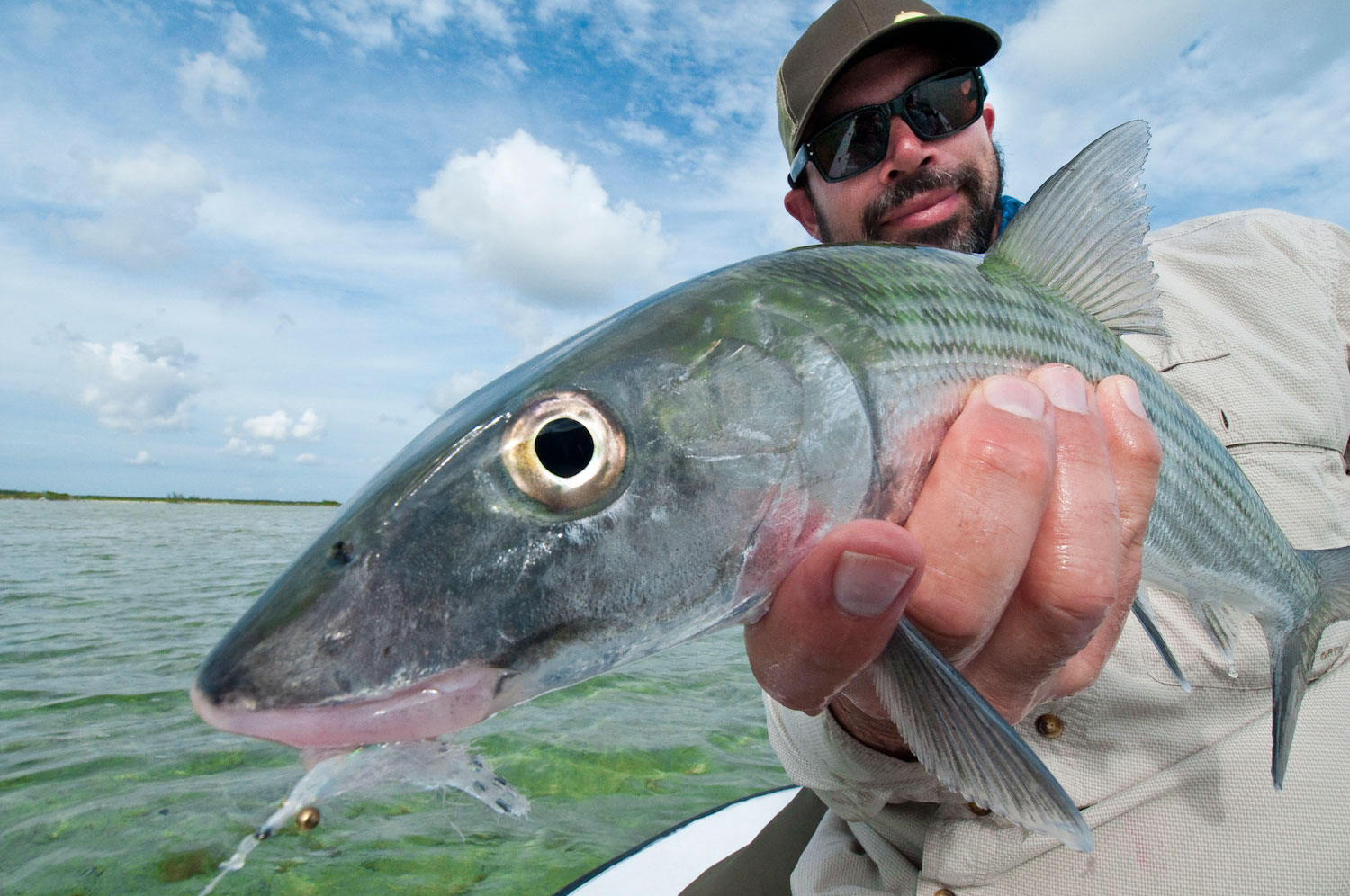
WE ALL KNOW THE HEARTBREAK OF SEEING A BIG FISH SPOOK AND RUN WHEN WE MAKE A CAST.
Whether its due to a poor presentation, the fish catching sight of us or something completely random and out of our control doesn’t matter. The pain is the same and it’s our natural reaction to consider that fish done and watch him swim away. For most species that’s the case, certainly for a wary trout but the bonefish is another subject.
Many times I’ve seen a bonefish spook and run or refuse a fly and turn away only to eat that same fly on the next cast. Maybe it sees the fly in a different light or from another angle that makes it more appealing or maybe it’s mood changes that quickly, I don’t know but it happens. What I do know is that as long as that fish is in range I will continue to show it that fly.
Read More »The Only Two Caddis Pupa Patterns I Really Need to Carry
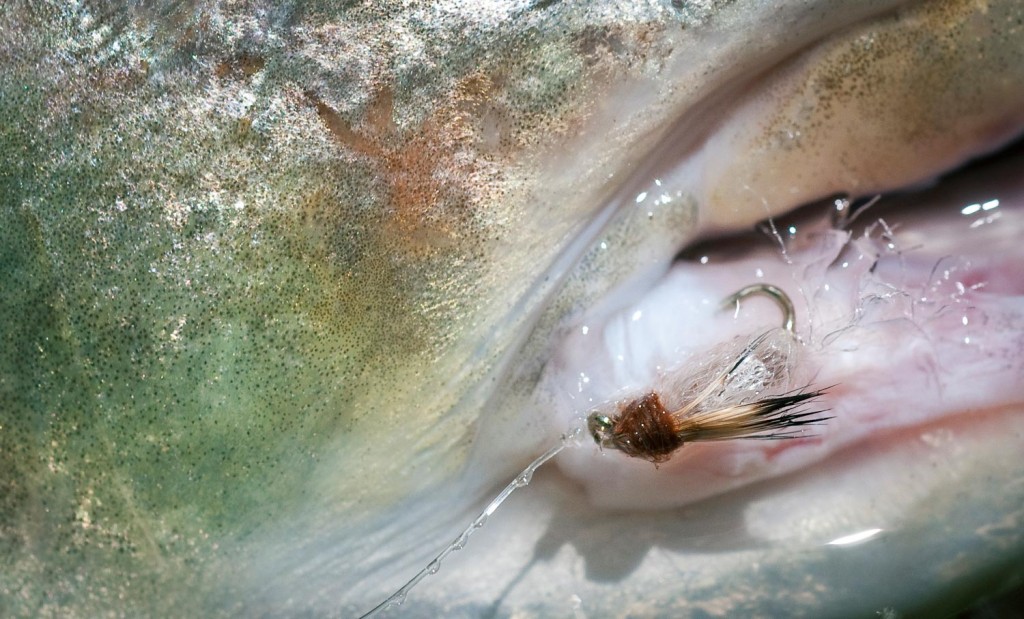
Caddisflies, who doesn’t love them? I can assure you trout sure do.
Tying a caddisfly imitation on, is usually not a bad move on any trout water you visit. Globally, there’s thousands of different species of caddisflies, and that fact alone, one could argue caddisflies are the most abundant and popular aquatic insects found in trout water. If I remember correctly, my first trout landed on a dry fly was with an Elk Hair Caddis. That was a long time ago, back when I knew nothing about fishing caddis pupa patterns and how important they were. I’ve since, with the help of the great Gary LaFontaine, author of the famous book, “Caddisflies”, deepened my knowledge of this aquatic insect, and I’ve built a whole new appreciation and respect for the importance they have in a trout’s diet. Year-round, but particularly during the spring, early summer and fall, fly anglers should be well stocked up on caddisfly pupa fly patterns.
It’s safe to say the most effective way to catch the trout during a caddisfly hatch is to fish caddis pupa imitations. I’ve got many different caddisfly pupa patterns in my fly box, but over the years, LaFontaine’s deep sparkle pupa and emergent sparkle pupa have caught me more fish than all the other pupa patterns combined. These patterns should be in every trout anglers fly box. Gary LaFontaine did an excellent job of researching and studying the characteristics, underwater look and behavior of emerging caddis pupa. He used aquariums with living caddisfly specimens, and spent countless hours scuba diving on rivers during caddisfly hatches to gain accurate insight of what the trout see during a caddisfly hatch. He then took the research and data he collected and hand picked fly tying materials that he could use to design and tie accurate caddisfly patterns for each life-stage of the aquatic insect. This was an astonishing feat that took Gary LaFonataine twenty years to compile and complete. We all owe him a great deal of gratitude and thanks for all his hard work. Without his contributions who knows where we’d be today in understanding
Read More »Louis’s Saltwater Casting Drill
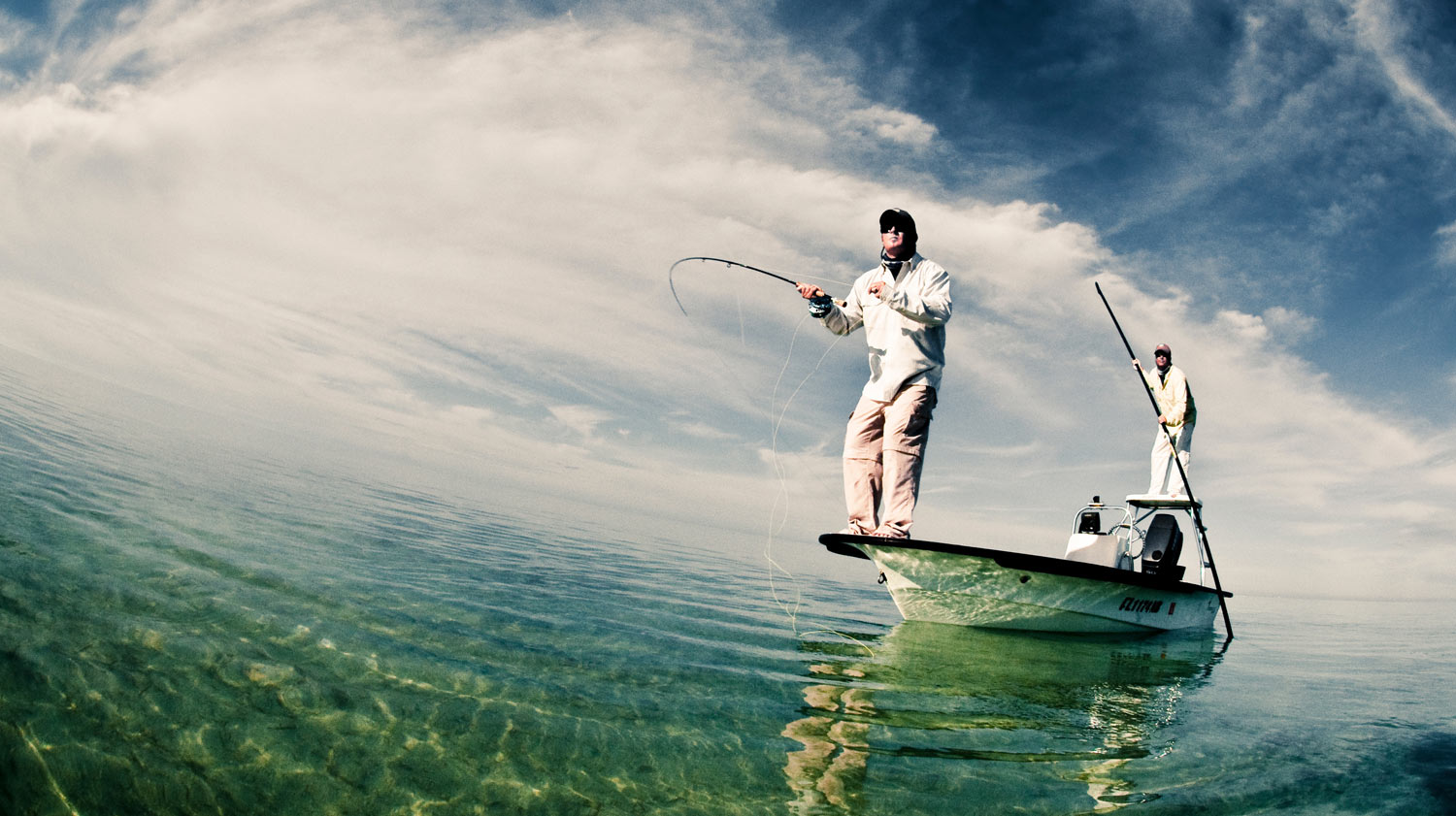
There’s no debate, practicing your casting makes you a more effective angler.
But all practice is not created equal. Simply heading down to the park and hucking as much line as possible doesn’t accomplish much. A while back we published a practice routine recommended by Tim Rajeff. If you haven’t seen that video, you should check it out. Any angler can benefit from Tim’s practice plan.
Today I’m going to add my own casting drill. This is a saltwater specific drill that works on a couple of techniques commonly used in saltwater fly fishing. It simulates making three presentations to a moving fish and it requires several tasks at once.
I lay out 3 hula-hoops in a line. The first at 40 feet, the next at 60 feet and the last at 80 feet. If you can’t cast 80 feet just shorten the gaps and work with the cast you have. I then step to the side so the three rings appear as a diagonal line. Starting in my ready position, I cast to the first ring, then pick up the line and cast to the second ring, and then the third. I do all of this with no false casting.
Don’t stress out about hitting the center of the rings. Your accuracy will improve with practice. Work on making the presentations efficiently without false casting, by shooting your line to the target. Pick the line up slow and smooth so your fly will not make noise and spook the fish. Work on making the three casts as quickly and accurately as possible.
I like this drill because it teaches several techniques in a realistic fishing scenario. If you can hit those three targets quietly in 10 seconds or less you’re going to do well on the water. It’s easier than it sounds. Just stay focused and keep practicing.
For the gear-heads, I’m casting the new
Read More »Fixing A Twisted Fly Line In Seconds
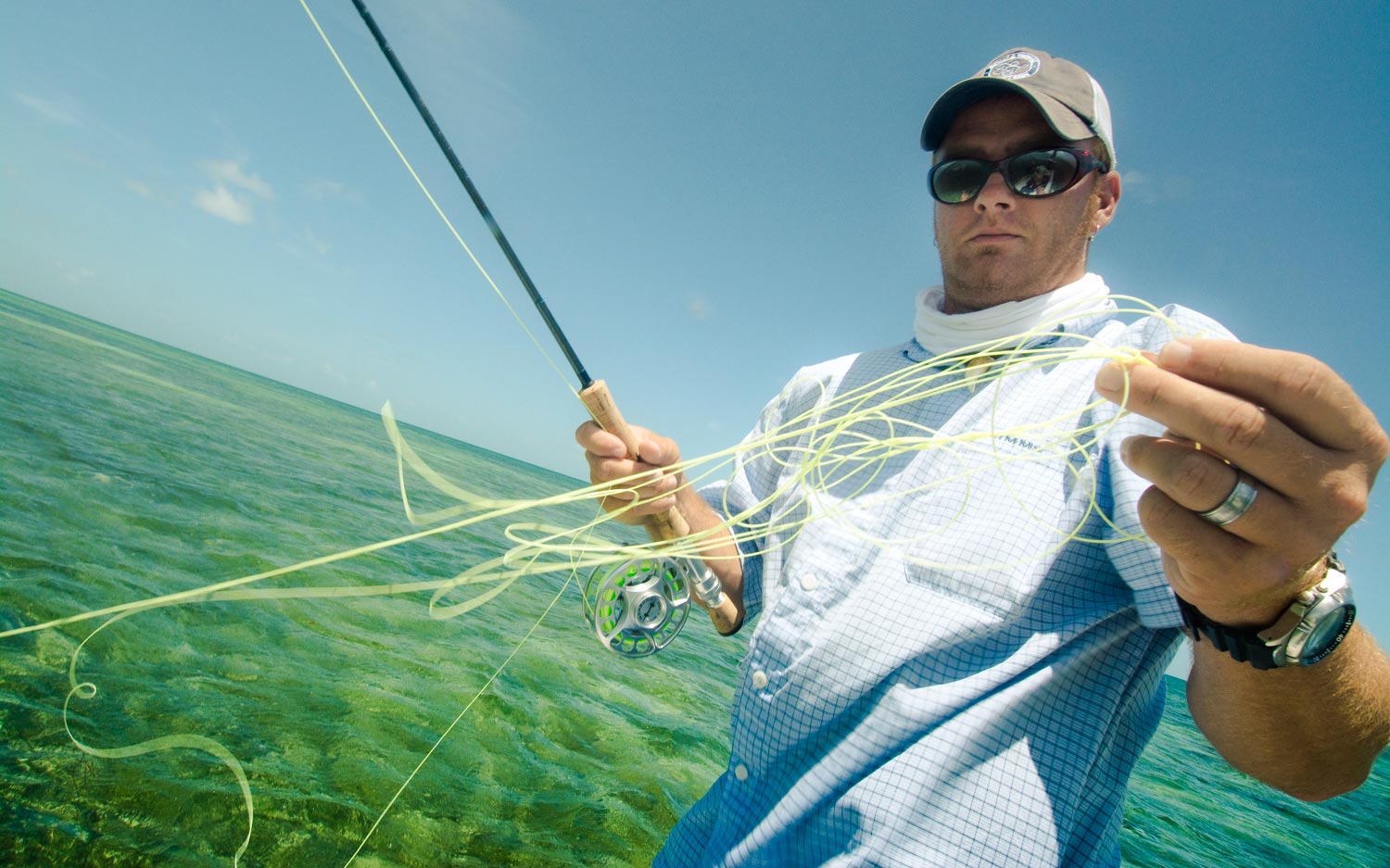
Every fly angler has experienced a wicked twist in their fly line causing it to tangle and knot at their feet.
It may be caused by a flawed casting stroke, a big fly twisting in the wind or it may be God punishing you for masturbating. Regardless of why it occurs, it’s frustrating at the least and heartbreaking at the worst. There’s nothing worse than taking a shot at the fish of a lifetime, only to have your cast cut short by a knot in your guides.
Fortunately, a twisted fly line is easy to fix. You don’t have to lose valuable fishing time, while stripping the entire line off the reel and towing it behind the boat or letting it hang in the current. You can fix that twist in seconds.
In this video, our good friend Zack Dalton from RIO Products shows you how.
Read More »Bends Are Like Best Friends
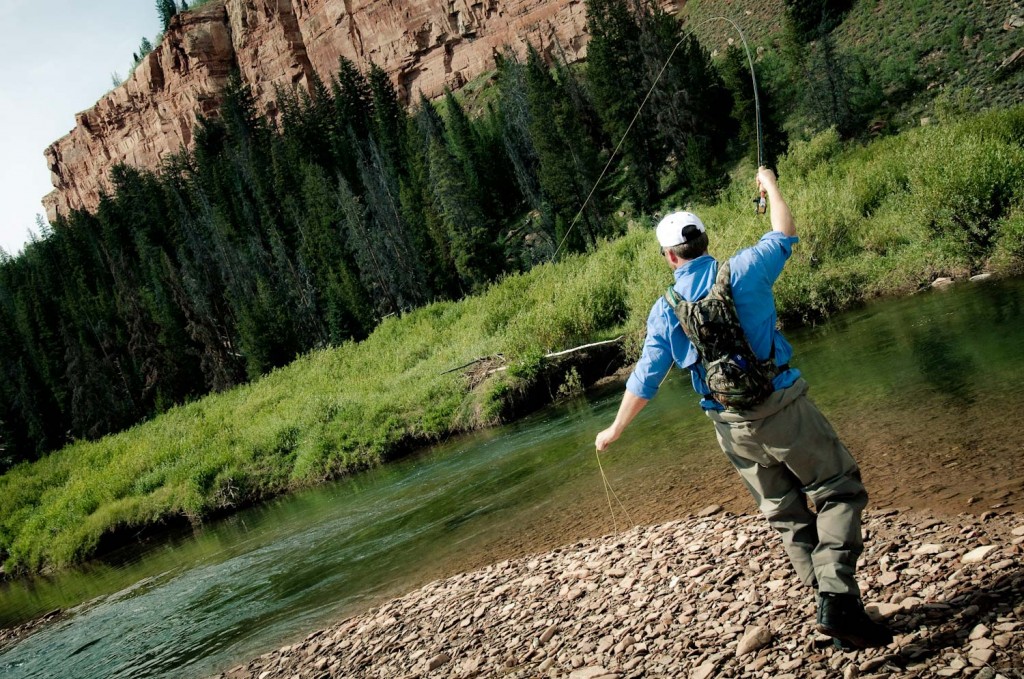
Bends in rivers and streams are like my best friends.
They possess all the qualities that I value and they always provide me consistent support in my endeavors. I don’t know about you, but when I find myself staring at a section of river or stream and I see a nice bend, I quite often head straight for it. I do this because I know it will usually produce a quality fish or two on the end of my line, and it’s generally very obvious to me where I should present my flies.
Just about every bend you encounter on the water will hold these three qualities.
1. One Well Defined Current
There usually will be one well defined current, collecting and moving food through the bend. This clearly indicates to anglers where the most food is drifting and where the fish should be positioned to intercept it.
2. Clear Channel or Trough
That well defined current usually has cut out a deep channel or trough in the bend. This reinforces further why fish will be located here. The deeper that fish can get below the surface and current, the less energy they’ll have to exert to maintain position and feed. The deeper water also provides
Swing For The Fence On Every Cast
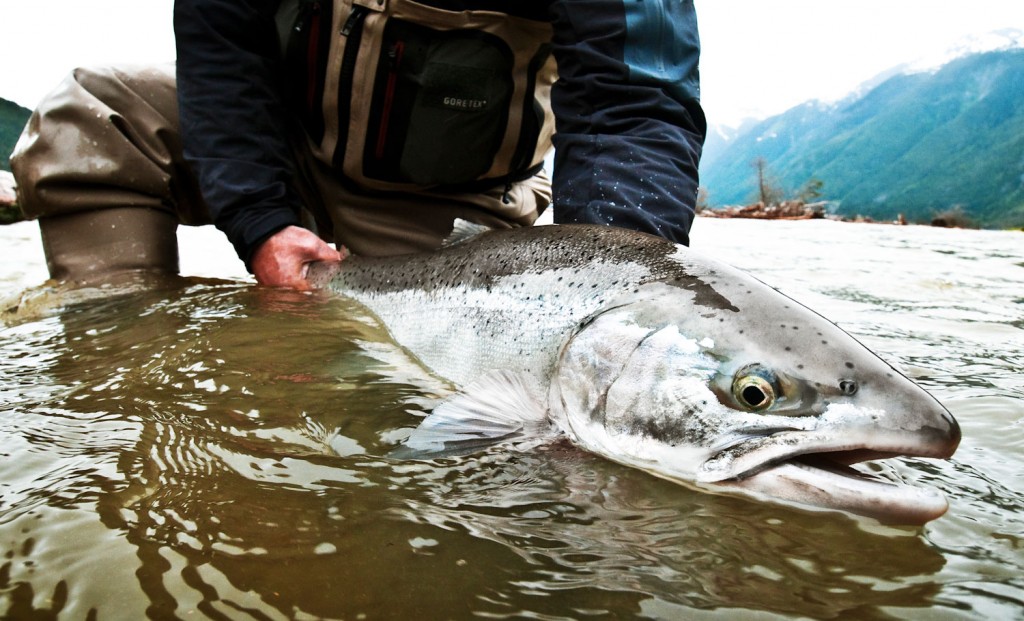
By Louis Cahill
After four days swinging flies in dirty water without a pull it’s easy to lose faith.
I faced some pretty tough conditions on a recent trip to the Dean River in British Columbia. Heavy rain turned the river into a raging mess of mud and floating trees. It was not a pretty sight, but I turned it around.
High water tactics can be laborious. Fishing long heavy sink tips and weighted flies makes casting a chore and swinging your fly a downright pain in the ass. You have to put the fly where the fish are and in high water they are hunkered down on structure or hugging the bank. Getting down to submerged structure in fast water means weight and lots of it. That means lots of hanging up on the rocks, especially at the end of your swing.
After four days with no action and hanging your fly up on every cast it’s easy to start avoiding the water that you know is going to give you trouble. Little things like picking up your fly just before it reaches the end of its swing or not giving that sink tip quite as long to sink makes robotic fishing easier on your nerves. The problem is, it doesn’t catch fish.
The worst is when, after days of toil without a fish, you snag that rock and immediately throw your line over it only to see it turn and bolt downstream without your fly in its mouth. We’ve all done it. I learned long ago that big fish often eat like rocks. I always hold pressure on a rock for a few seconds at least. It’s paid off many times and it paid off again in BC.
After four days of fishing and clearing ten thousand snags, when my fly stopped I held on, maybe ten seconds, before a beautiful bright steelhead gave me a sign of life. Ten seconds feels like an eternity at the end of four days but it’s like Lou Reed says, “You need a bus load of faith to get by.”
Kent calls it fishing with confidence. Faith or confidence, either way a good fisherman always believes in his heart that, this is the cast. Eventually he’s right. My numbers were
Read More »The Tequeely Streamer
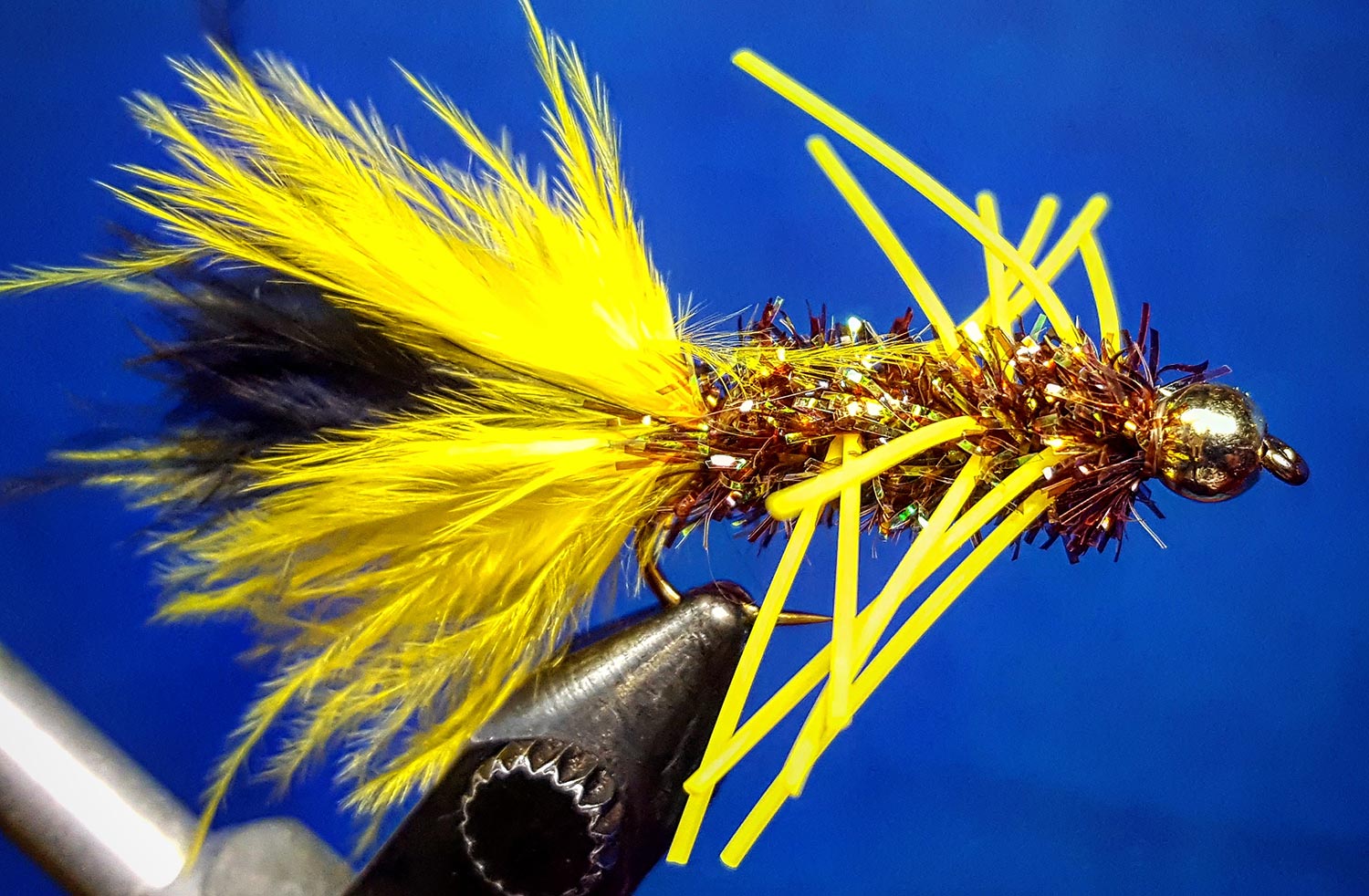
By Bob Reece Some patterns simply brighten up a fly box with their aesthetics. Hopefully, if they’re in your box, their visual appeal is matched by their effectiveness. This tandem of traits is true for the Tequeely streamer. After extensive research I was unable to find the creator of this pattern. I’ve heard stories of it originating in Montana as an imitation of newly hatched baby birds that would frequently fall from their streamside nests. Regardless of whose mind it came from or its original purpose, the fact remains that it works. On the freestone waters of Colorado and Wyoming that I fish, May through early July typically produces higher water that carries some color. Flash reigns supreme in these conditions. Yellow marabou and rubber legs along with a reflective body, turns this streamer into an underwater beacon. The gold bead only adds to this and provides the needed weight to punch this pattern through the surface film. While its imitational intentions remain clouded, the results that this streamer produces do not. Its combination of traits trigger a response in dominant fish, particularly large browns. However, its uses since inception have reached numerous species of fish. If you’re in search of a flashy producer for you streamer arsenal, add this bling filled bug to your box. Watch the video and learn to tie the Tequeely: To see more tying videos by Bob Reece, click the link below: http://www.thinairangler.com/tying-videos To connect with Bob Reece as your personal Fly Coach, click the link below: http://www.thinairangler.com/fly-coach Bob Reece Gink & Gasoline www.ginkandgasoline.com hookups@ginkandgasoline.com Sign Up For Our Weekly Newsletter!
Read More »Dicky’s Tarpon Silencer
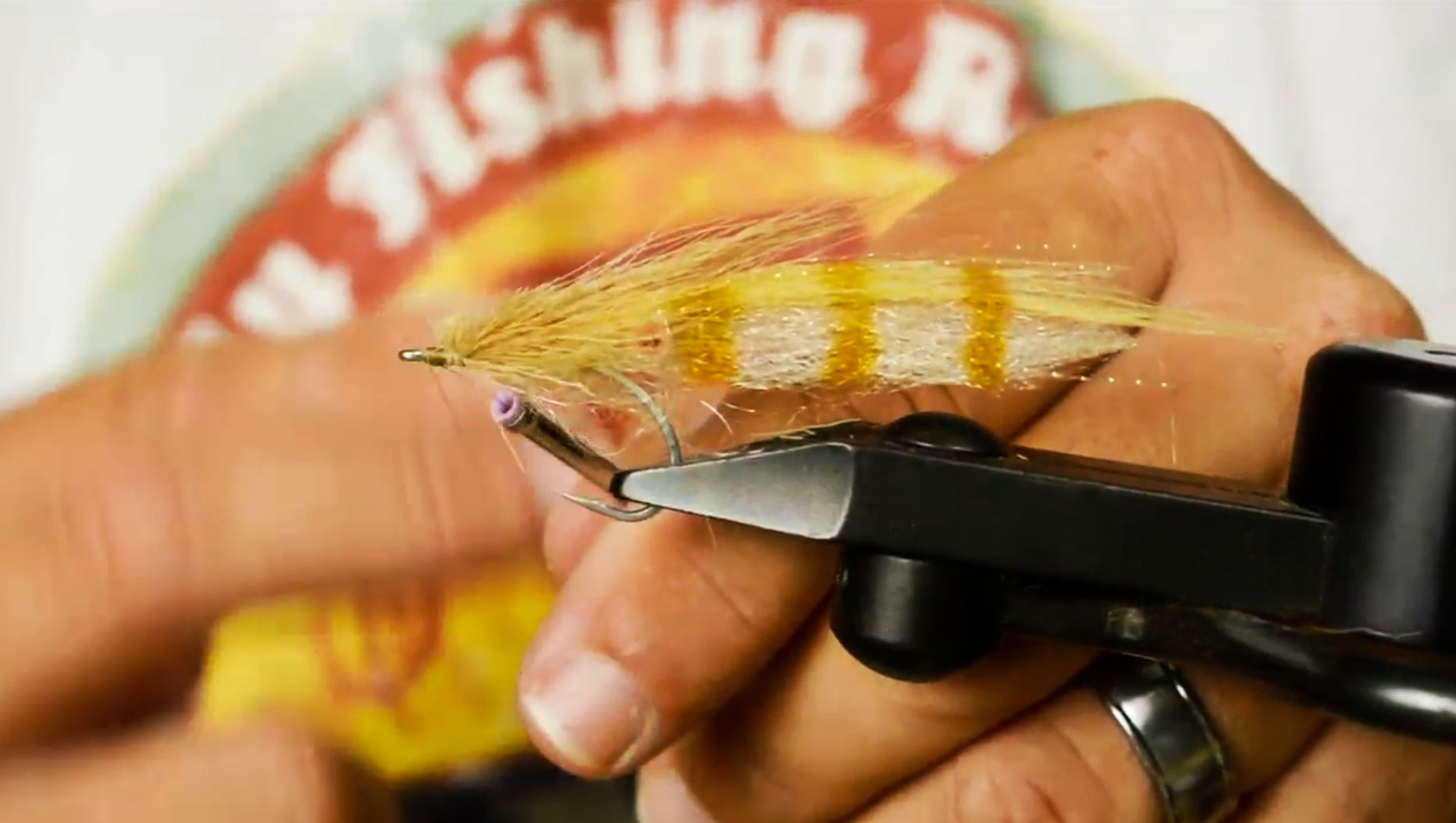
WHO’S AFRAID OF THE BIG BAD FLY?
On dead calm days in the Florida Keys the silver king can be afraid of his on shadow. I’ve seen plenty of big tarpon vanish at the sound of the fly landing on the water. As a flats guide, so has Joel Dickey. That’s why he came up with this fly that the calls the Tarpon Silencer. The Silencer lands so softly that even the most skittish tarpon keep their cool and it’s shrimpy profile is irresistible.
If you’re planning a trip to the Keys, or any tarpon fishing destination, this is a fly you want in your box.
Watch the video and learn to tie Dicky’s Tarpon Silencer.
Read More »Fight The Good Fight, in Saltwater or Fresh

MY FRIEND KIRK DEETER SAYS FRESHWATER AND SALTWATER FLY FISHING ARE, “TWO ENTIRELY DIFFERENT SPORTS PLAYED WITH THE SAME EQUIPMENT.”
In essence that is true and Kirk’s point is doubly true. Anyone who’s tried both can attest to that, but some of that equipment looks more similar than it is.
Reels, lines, leaders, hooks, tying materials are all different but there is likely no piece of equipment more different than the rod. There are a lot of differences between freshwater and saltwater rods and in several ways their use is quite different. This became readily apparent while giving a good friend, who guides for trout, a quick lesson before is first bonefish trip. He’s a great fisherman and caster but I could see from the look on his face that the eight weight I was lending him was strikingly unfamiliar.
We’ve talked a good bit about saltwater casting, the double haul and line speed but for those who are making the switch from trout to saltwater fly fishing, I’d like to offer some pointers on the techniques that I feel are the least intuitive. The fighting of fish.
When it comes to the fight, the trout rod and the saltwater rod are truly two different tools and they require different techniques. The divergence of those techniques starts with a fundamental element, the fish. It is the difference in the fish that dictates both the design of the rod and the tactics employed in its use.
Read More »Winter Steelhead on the Fly: Video
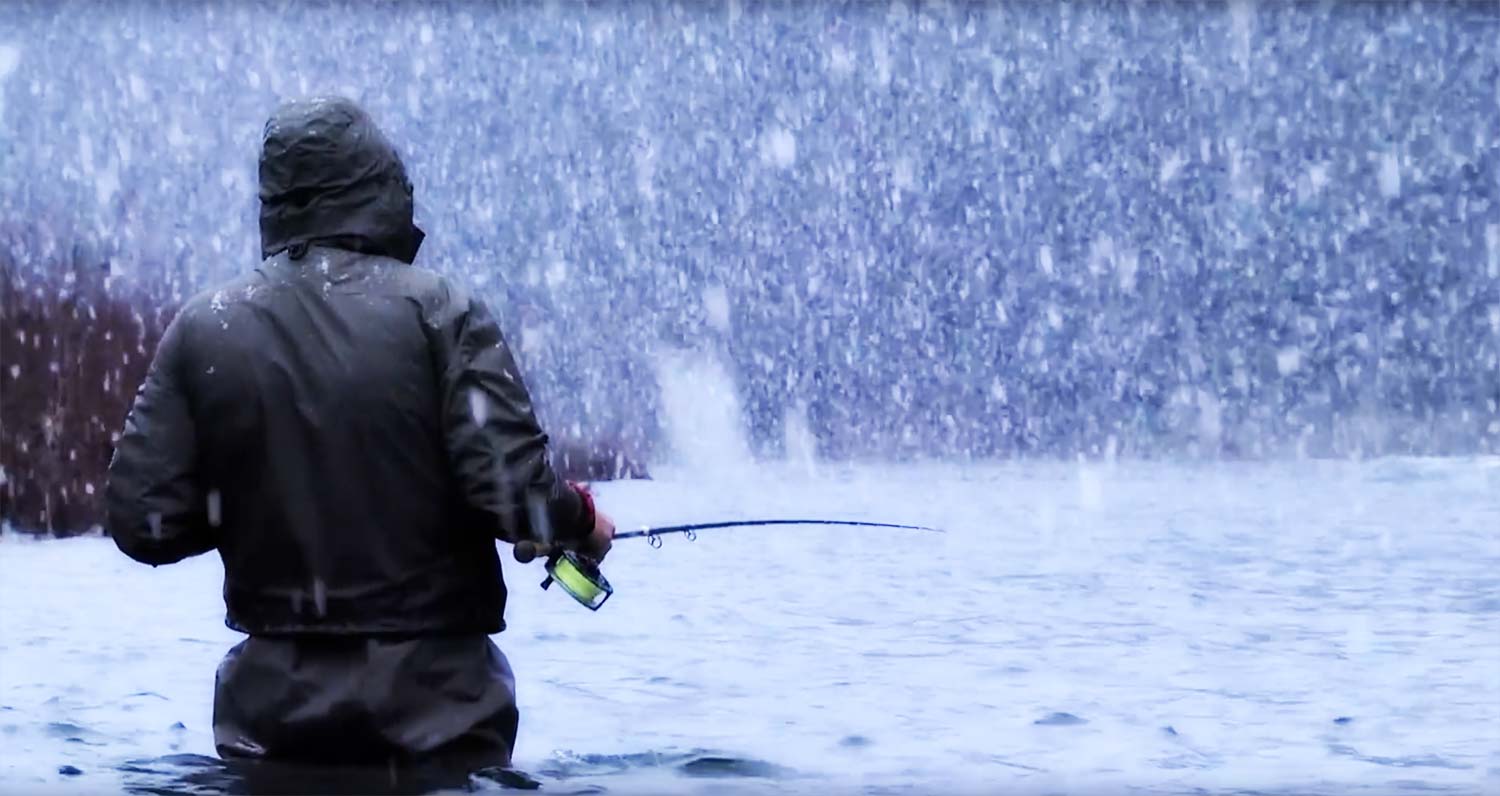
Winter is here and, for those willing to brave the elements that means big winter steelhead.
Unfortunately, there will be no steelhead for me this winter. That doesn’t mean they aren’t on my mind and if I can’t get after them myself, I can at least watch my buddies do it. This great video by Todd Moen from 2014 features my buddy Jeff Hickman and is one of my favorites.
ENJOY, “WINTER RUN, PACIFIC NORTHWEST WINTER STEELHEAD FLY FISHING”
Read More »